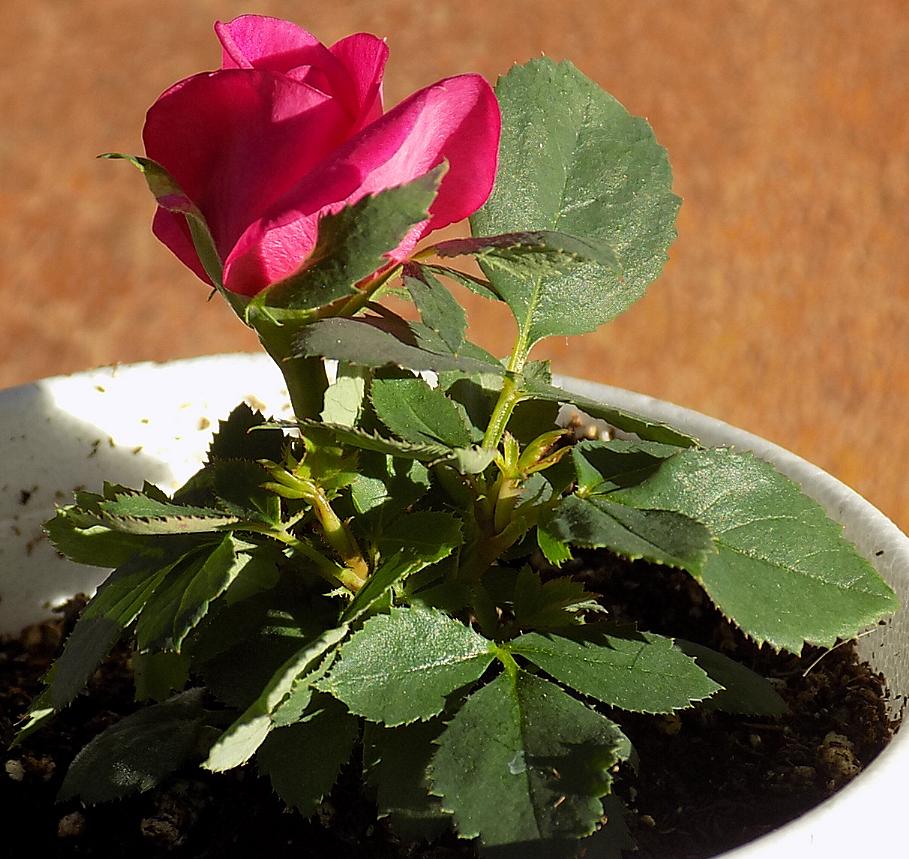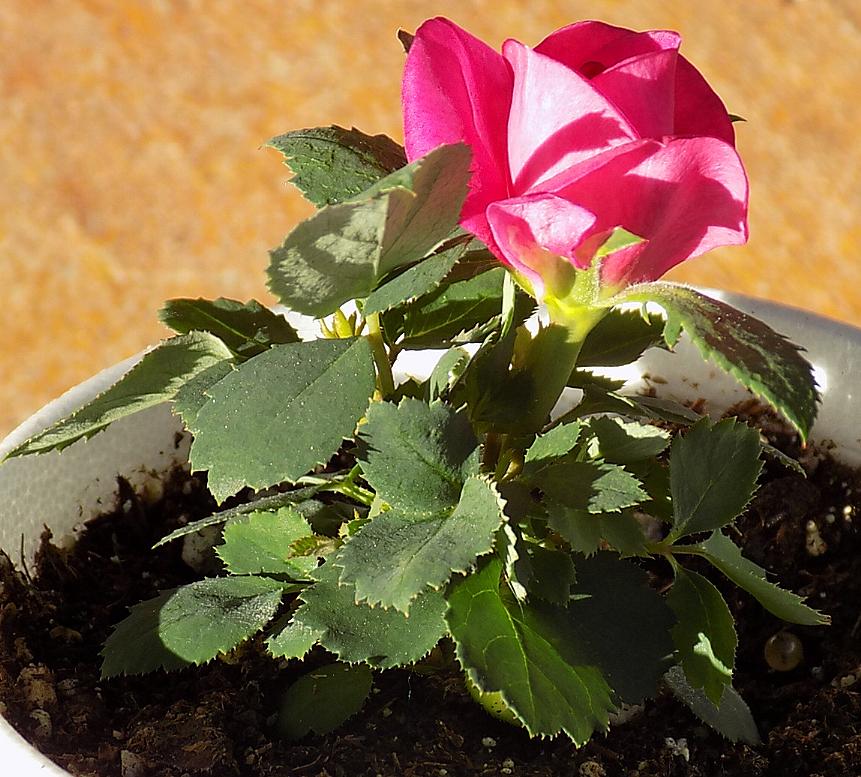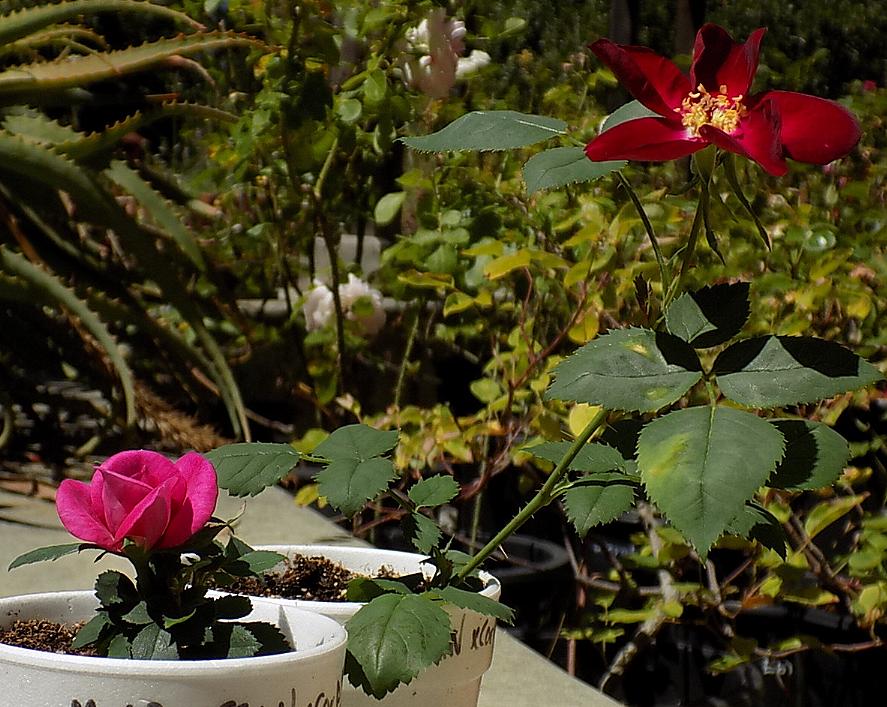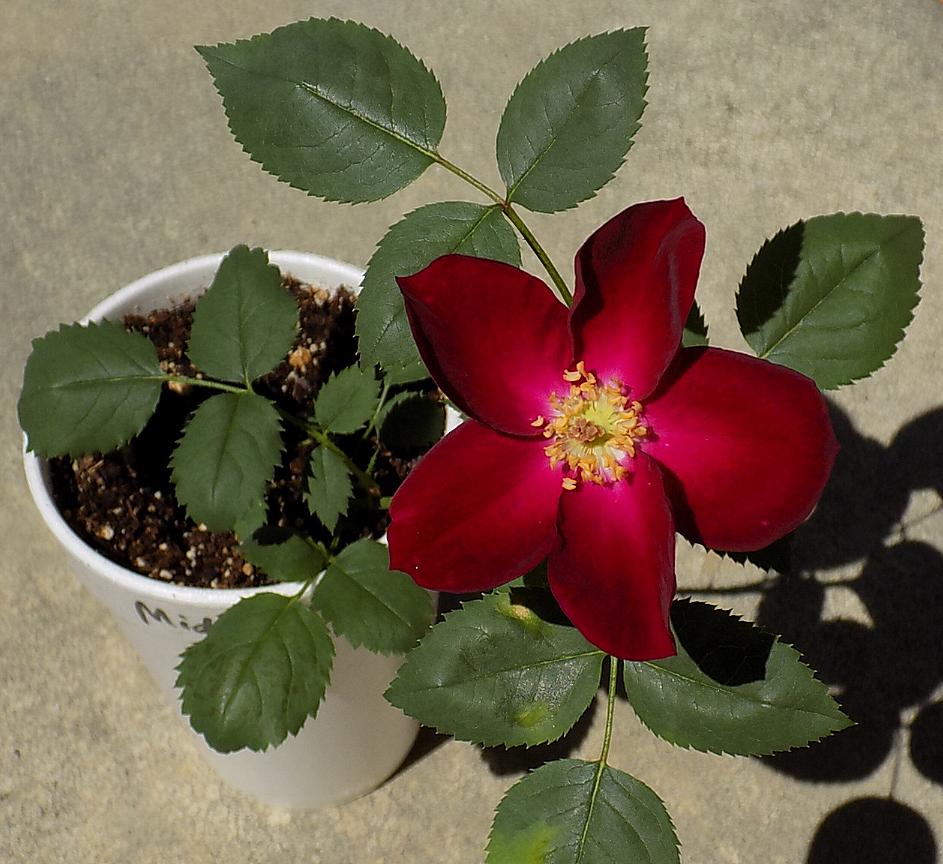This seedling is from the cross Midnight Blue x (Schoener’s Nutkana x Coral Dawn). The parents aren’t minis, and this seedling doesn’t look like a normal mini. It is smaller (2 1/4" tall); less than half the height of mini seedlings the same age. It is branching and probably has as many leaves as other seedlings its age, but the internode distance is much shorter. The leaves are small and have three leaflets. It hasn’t formed any prickles yet. None of the other seedlings from this cross have this growth habit, although some are prickle-free. In the 17 years that I’ve been hybridizing, I’ve seen this growth habit a few other times, but I didn’t think those seedlings were worth keeping. I’m going to keep this one and try breeding with it to see if it passes these traits to its offspring.


Very pretty rose. I would call this a dwarf, not a mini. The distinction I see is that a mini has a proportional internode length, or perhaps even as proportionally longer than, a larger rose when considered in terms of leaflet size to internode length. A so-called climbing mini has longer internodes and usually more leaves below a flowering cluster. But both leaves and flowers are small. A micro mini has both leaves and internodes smaller. Generally the flower is proportionately small.
A dwarf has a shortage of gibberellin probably. In something like brassicas (Wisconsin fastplants for instance) a dwf will not make the typical shoot for “bolting” into flower. The flowers come directly from the rosette of leaves that is the normal early vegetative form. Adding a dose of GA will convert it to a normal looking plant with flowers along a tall stem.
I have a seedling of a mini x R pomifera (from David Z) which is in my opinion a dwf, with normal-looking leaves but never growing over 8 inch tall in at least 6 yrs. Its OP seedlings look the same. By contrast a seedling of R pom x Soeur Therese grew a cane of over 3 ft in one season (2nd yr) with leaves larger than Soeur T. Maybe next year it will flower so that I can do another cross.
Thanks Larry! I like using the term “dwarf” to distinguish this growth habit from conventional minis. Does your dwarf repeat? Do you have any pics of it to share? I’d love to see it.
Here’s a pic of my dwarf with a normal-sized seedling from the same cross that opened its first bloom today. The dwarf is fragrant. The red single has no fragrance, and unlike the dwarf, it has prickles.


It’s probably a little early to call for this seedling, I feel. I have had similar seedlings that seem to be small to begin with which take some extra time to get going and once they do they catch up with the others, more-or-less. Almost like they were trying to sort out their newly acquired genetics before they ‘got-it-right’. Given the fairly wide nature of the cross this may well be the case here, too. Might it also be the result of some difficult ploidy combinations? If Nutkana is hexaploid and ‘Paul Neyron’ is a conventional tetraploid then ‘Schoener’s Nutkana’ might have strange ploidy (like pentaploidy). I don’t know what the ploidy of ‘Coral Dawn’ is but I would guess either triploid or tetraploid and ‘Midnight Blue’ would be a tetraploid… so who knows how this cross has turned out in terms of ploidy.
I also remember reading articles by Paul Barden and Kim recounting conversations they have had with Mr Moore about miniatures. Paul and Kim will have to fill in the gaps here because my memory is not 100% reliable on the topic, but if I recall correctly he believed there was more than one type of factor influencing the stature of roses which resulted in them being ‘miniature’. He said there was a type of miniature derived from varieties such a ‘Rouletii’ and another that was derived from wichurana which, if my memory serves me correctly, he referred to as polyantha dwarfing (like ‘The Fairy’ which derives from ‘Bardou Job’ x wichurana and ‘Paul Crampel’). ‘Coral Dawn’ is wich-based so maybe wichurana is influencing the expression of height? Further to this, it was suggested that if both miniature factors were combined micro-miniatures would arise.
I think one of Moore’s most important comments was on the similarity of witches’-brooms to miniature rose. This is an uncomfortable subject these days due to the spread of RRD. But the observation still seems appropriate.
http://bulbnrose.x10.mx/Roses/breeding/Moore/MOORE.html
Witches-brooms can be induced by the application of cytokinins: “Cytokinins are a class of plant growth substances that promote cell division, or cytokinesis, in plant roots and shoots.” Wikipedia
One aspect of evolution and speciation is chromosome remodeling. Blocks of genes that are found on chromosome 1 of species A, may be located on chromosome 2 of species B. In second or later generations from the cross A x B may inherit duplicate genes … 3 or 4 copies instead of the normal 2. If genes related to the production of cytokinins are involved, the growing plants may be so busy branching and flowering that they can’t make much upward growth. Minis!
In this model, it is not that Rosa wichuraiana carries any special dwarfing factor, but that one or more genes influencing cytokinin production are located in different chromosomes of R. wichuraiana than in the China/Tea/etc. derivatives.
In fact, the differences in location of some cytokinin-related genes seem to be present in ‘Old Blush’.
“I have shown that miniatures can be, and have been, produced from the seedlings of certain varieties, such as Old Blush, and also from crosses of dissimilar kinds as with my crosses of Rosa wichuraiana x Goldilocks, etc.”
Dwarfs and Minis have turned up in hybrids of other plants. For example, Burbank’s very vigorous Paradox walnut was a hybrid of Juglans regia x J. Hindsii. The F2 generation seedlings included dwarfs as well as giants.
Very interesting Karl. Each of the three roses in this cross has a species rose in its not too distant past.
Midnight Blue has R. soulieana
Schoener’s Nutkana has R. nutkana
Coral Dawn has R. wichurana
In reading about plant hormones and dwarfism, it seems that there are two common kinds, one related to a gibberrelin deficiency and one related to an excess of cytokinin. The growth habits of the two are quite different. I think mine resembles the cytokinin-related dwarfism.
Good point about the gibberellins.
There once was a Mini HP called ‘Clibran’s White’. It grew just 8.5 inches to 1 foot at most, yet it flowered abundantly (according to the breeder).